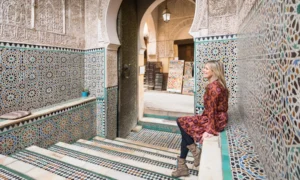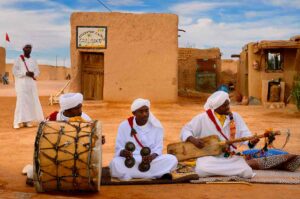Introduction: Why the Fez to Marrakech Trip Is Morocco’s Most Magical Route
The Fez to Marrakech trip is more than a route—it’s a journey through Morocco soul. This legendary path links two imperial cities and captures the spirit of the country like no other. Along the way, travelers cross mountain passes, vast deserts, and ancient villages that have stood for centuries.
From the spiritual calm of Fez to the electric pulse of Marrakech, this trip unfolds like a living storybook. Every kilometer reveals a new chapter of Moroccan life—faith, art, and adventure merging into one unforgettable travel experience. Whether you seek culture, history, or breathtaking landscapes, the Fez to Marrakech trip is the ultimate way to discover the real Morocco.
Fes — The Spiritual and Cultural Heart of Morocco
Welcome to Fes, Morocco’s oldest imperial city and its cultural soul. Founded in 789 AD by Idris I, Fes has been a center of faith and learning for over a millennium. It’s a city where time slows down and every wall whispers history.
A Fes Morocco day tour feels like stepping into a medieval world that’s still alive. The narrow streets of the Fes el-Bali Medina, the rhythmic sound of artisans at work, and the scent of leather from the Chouara Tannery transport travelers back centuries. For many, Fes isn’t just a destination; it’s a revelation — a mirror reflecting Morocco’s spirit.
Inside the Medina of Fes el-Bali: A Living UNESCO Masterpiece
The Fes el-Bali Medina is a labyrinth of culture and chaos. With over 9,000 alleys, it’s one of the largest car-free zones in the world. Wandering here means discovering something new at every turn — a blue-tiled fountain, a craftsman hammering brass, or the aroma of cumin and sandalwood drifting through the air.
Recognized by UNESCO as a World Heritage site in 1981, the medina preserves a way of life that hasn’t changed much in centuries. The deeper you explore, the more Fes reveals its magic — not through grand monuments, but through everyday details: laughter, color, and craftsmanship that connect past and present.

The City’s Imperial Legacy and Dynastic Foundations
Fes’s identity was shaped by Morocco’s greatest dynasties — the Idrisids, Almoravids, Almohads, and Marinids. Each dynasty built monuments that still define the city’s skyline today. The Marinids, in particular, left a legacy of architectural brilliance through madrasas like Bou Inania and Al-Attarine, showcasing exquisite zellij tilework and carved cedar.
This dynastic heritage gave Fes its distinctive look — a fusion of Andalusian and North African artistry. Understanding this legacy transforms your Fez to Marrakech trip into more than a vacation. It becomes a journey through Morocco’s imperial memory, one dynasty at a time.
The Soul of Learning: Al-Qarawiyyin University
At the heart of Fes stands the University of Al-Qarawiyyin, founded in 859 AD by Fatima al-Fihri — a woman ahead of her time. It’s the oldest continuously operating university in the world, recognized by both UNESCO and Guinness World Records.
For over 1,100 years, Al-Qarawiyyin has been a beacon of learning in the Islamic world, producing scholars who shaped global thought. Its legacy continues to inspire Fes, where education and faith still intertwine. Every Fez to Marrakech trip begins with this intellectual foundation — the idea that travel itself is a form of knowledge.
From Fes to the Desert: The Road to the Sahara
Leaving Fes, the journey south transforms dramatically. Olive groves give way to cedar forests as you enter the Middle Atlas Mountains. In Ifrane, nicknamed “the Switzerland of Morocco,” alpine architecture and cool air surprise first-time visitors.
Further south lies Azrou, a Berber town famous for its monkeys and cedar trees, followed by Midelt, the halfway point to the desert. As you descend toward the Ziz Valley, palm groves and mudbrick kasbahs signal your arrival in Morocco’s desert frontier. This is where your Fez to Marrakech trip begins to whisper the call of the Sahara.
Through the Sahara: From Fes to Merzouga
The closer you get to Merzouga, the more the landscape dissolves into gold. The Erg Chebbi Dunes, some reaching 150 meters high, stretch endlessly across the horizon. Here, adventure takes the form of silence, starlight, and sand.
Ride a camel into the dunes at sunset, and the Sahara reveals its beauty in pure simplicity — colors shifting from copper to violet before darkness unveils a sky overflowing with stars. Sleeping in a Berber desert camp connects you with Morocco’s nomadic heritage and offers peace found nowhere else on Earth.

Life in the Desert: Berber Heritage and Timeless Hospitality
The people of the Sahara embody resilience. Their hospitality turns a harsh environment into a place of warmth. Around the campfire, Berber musicians share songs that echo through the dunes, stories that have survived through centuries.
Morning brings a desert sunrise that feels sacred — the dunes glowing in shades of orange and gold. For travelers, this moment defines the essence of the Fez to Marrakech trip: a blend of nature, culture, and self-discovery under an infinite sky.
The Atlas Mountains: Morocco’s Majestic Spine
Leaving Merzouga behind, the road climbs toward the Todra and Dades Gorges, where cliffs of red limestone frame narrow rivers. The views are mesmerizing — a raw, cinematic beauty that seems to belong to another world.
As you ascend the High Atlas, villages appear like mirages against snowy peaks. Crossing the Tizi n’Tichka Pass, one of Morocco’s highest roads, offers sweeping panoramas that leave travelers speechless. This leg of the Fez to Marrakech trip is where the desert’s heat meets the mountain’s chill, a breathtaking reminder of Morocco’s diversity.
Arrival in Marrakech: The City of Light and Life
Descending from the mountains, the Red City of Marrakech bursts into view — a living mosaic of sound, scent, and color. The Koutoubia Mosque towers over the skyline while the chaos of Jemaa el-Fnaa square pulses with storytellers, snake charmers, and sizzling food stalls.
Marrakech is a feast for the senses. Explore the Bahia Palace, the Saadian Tombs, and the enchanting Majorelle Garden, once owned by Yves Saint Laurent. At sunset, sip mint tea on a rooftop terrace and watch the city glow. It’s the perfect ending to your Fez to Marrakech trip, blending ancient charm with modern rhythm.
7-Day Fez to Marrakech Itinerary
Day 1 – Arrive in Fes: Explore Fes el-Bali and dine in a traditional riad.
Day 2 – Discover Fes: Visit Al-Qarawiyyin University, Chouara Tannery, and Bou Inania Madrasa.
Day 3 – Fes to Midelt: Travel through Ifrane and Azrou; overnight in Midelt.
Day 4 – Midelt to Merzouga: Pass Ziz Valley and Erfoud before arriving at the dunes.
Day 5 – Merzouga to Dades: Sunrise camel ride; continue to Todra and Dades Gorges.
Day 6 – Dades to Marrakech: Visit Aït Benhaddou, cross Tizi n’Tichka Pass, arrive in Marrakech.
Day 7 – Explore Marrakech: Souks, Bahia Palace, Majorelle Garden, and final dinner.
Cultural Tips for Travelers
-
Dress modestly, especially in Fes and rural areas.
-
Always greet locals with “Salam Alaikum.”
-
Bargaining in souks is expected — stay friendly and smile.
-
Accept invitations for tea; it’s a gesture of respect.
-
Ask before photographing people, especially artisans or elders.
Following these customs enhances not only your trip but also your connection with Morocco’s culture — an essential part of any authentic Fez to Marrakech trip.
Frequently Asked Questions (FAQ)
1. How long is the Fez to Marrakech trip?
The route from Fez to Marrakech is about 530 km (330 miles). Most travelers take 3–7 days to fully enjoy the journey through the desert and mountains, though it can be done faster by car or flight.
2. What’s the best time to travel from Fez to Marrakech?
The ideal months are March to May and September to November, when temperatures are moderate. Summer can be very hot in the desert, and winter nights can be freezing.
3. Can I do the Fez to Marrakech trip in reverse?
Absolutely! Many travelers begin in Marrakech and end in Fes. The experience is equally rewarding, though desert sunsets tend to feel more magical when arriving from the north.
4. What are the must-see stops on this trip?
Don’t miss Ifrane, Azrou, Ziz Valley, Merzouga Dunes, Todra Gorge, Aït Benhaddou, and the Atlas Mountains before reaching Marrakech.
5. Is the Fez to Marrakech trip safe?
Yes — Morocco is generally safe for travelers. Just use common sense, hire licensed guides, and avoid walking alone in remote areas at night.
6. Should I rent a car or join a tour?
If you’re an adventurous traveler, renting a car offers freedom. However, guided tours provide local insights, language support, and easier desert navigation.
7. What should I pack for the trip?
Bring light layers, a hat, sunscreen, comfortable shoes, and a warm jacket for cool desert nights. Don’t forget your camera — every moment is picture-perfect!
Conclusion — The Soul of Morocco in One Route
The Fez to Marrakech trip is not just about reaching a destination; it’s about transformation. You begin in Fes, surrounded by centuries of wisdom and tradition, and end in Marrakech, where creativity and chaos coexist in harmony. Between them lies every face of Morocco — serene, wild, sacred, and alive.
As you look back, you’ll realize the true gift of this journey isn’t the photos or souvenirs but the feelings it leaves behind — the silence of the Sahara, the laughter of Marrakech, and the timeless lessons of Fes. This is more than travel; it’s an awakening. And once you’ve taken the Fez to Marrakech trip, Morocco will live in your heart forever.
